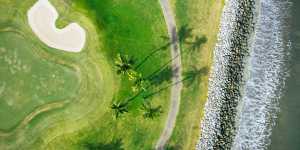On five hectares,an organic garden has started to flourish,supplying the adjacent Sheraton Fiji Golf and Beach Resort with many of its vegetables,fruits and herbs. Using food waste from the hotel’s extensive kitchens in the compost and sustainable no-till farming practices among other well-thought-out initiatives,the garden is a brilliantly productive use of land for the hotel’s hundreds of daily guests,not just golfers.

Denarau Golf& Racquet Club’s golf course now flourishes with organic veggie gardens.Supplied
Guests are invited to learn about organic gardening and hydroponics,plant fruit trees and track the herbs and vegetables back to the cocktails and meals they’re used in. (It’s a great activity for kids.) Resort activities include delicious breakfasts in the garden,feasting on its produce such as sugar cane juice and juicy red Hawaiian pawpaw.
When I visited the resort last year,it opened my eyes to the potential use of golf courses for more than golf. Golfers may not wish to give their greens to vegetable gardens or holes to beehives,but there’s a reckoning coming on how courses can better benefit communities and the environment.
You can probably tell that I’m not a golfer,but I don’t have anything against the sport itself. Over three million people have participated in a game of golf in the past year,according to Golf Australia. Golfers argue that it’s a healthy outdoor activity and it’s not as elitist as it is often portrayed,due to the number of public golf courses charging modest fees.

Where greens meet Fijian coast.Supplied
It’s not the golfers that are the issue,though,but the courses. Keeping greens green involves large amounts of water and chemical pesticides and fertilisers,which can leach into water systems and drift over neighbouring properties. Clearing the land in the first place to make those lovely smooth slopes destroys biodiversity,as does the constant manicuring of the grass.
And when inner-city land for housing or other community purposes is in short supply,aren’t all those lush fairways a luxurious use of land we no longer can sustain? Wouldn’t they better be reimagined for the many,not the few?
In Sydney alone,thousands of hectares of land in urban regions are devoted to both public and private golf courses,some controlled by clubs with just a few hundred members. In one high-profile case,the NSW government is proposing to cut the inner-city Moore Park golf course in half and convert nine holes of the public course to parkland.

The organic garden supplies the resort with many of its vegetables,fruits and herbs.Supplied
Around the world,failing golf courses are being repurposed for community sports,seniors’ villages,luxury and affordable housing and rewilding projects. The Elsternwick Park golf course in Melbourne is one case in point – dwindling interest in golf meant the private 20-hectare course was handed back to the Bayside Council,where it was reclaimed as wetlands and a nature reserve for the community.
Interest in the sport is declining in the US,which holds 51 per cent of the world’s courses. Club closings outweighed new openings every year since 2006. Lack of leisure time and expense seem to be the main problems. Conservation non-profits and governments are seeing this as an opportunity to acquire courses and return them to nature.
Many golf clubs have seen the writing on the wall and address water use and biodiversity with measures such as harvesting stormwater and planting native species. They also consult with environmental groups to mitigate the damage courses are doing. In the US,the Audubon Society has partnered with 700 golf clubs to create more than 400 hectares of new habitat for endangered Monarch butterflies by planting the milkweed the butterflies need to survive.

Denarau leads a trend of golf courses becoming more environmentally minded.Supplied
But until the chemicals are gone,isn’t it just a case of greenwashing the greens?
Turning existing golf courses organic might be the way of the future – the only way to save them,perhaps. But it’s not happening in a hurry. I could find only one club in the US that has a 100 per cent organic course,the Vineyard Golf Club on Martha’s Vineyard. In Australia,KDV Sport centre and golf course on the Gold Coast is 100 per cent organic. There’s also Kabi Organic Golf Course and Orchard in Queensland.
According toGolf magazine,organic golfing produces fairways that are as beautiful and playable as those using pesticides. Since going organic is optional for clubs,the biggest hurdle for members is financial risk.
Perhaps one day it might not be optional.
The writer was a guest of Sheraton Fiji Golf and Beach Resort.